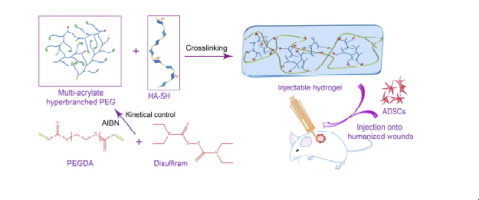Acta Biomaterialia ( IF 9.4 ) Pub Date : 2018-05-25 , DOI: 10.1016/j.actbio.2018.05.039 Qian Xu , Sigen A , Yongsheng Gao , Linru Guo , Jack Creagh-Flynn , Dezhong Zhou , Udo Greiser , Yixiao Dong , Fagang Wang , Hongyun Tai , Wenguang Liu , Wei Wang , Wenxin Wang

|
The injectable hydrogel with desirable biocompatibility and tunable properties can improve the efficacy of stem cell-based therapy. However, the development of injectable hydrogel remains a great challenge due to the restriction of crosslinking efficiency, mechanical properties, and potential toxicity. Here, we report that a new injectable hydrogel system were fabricated from hyperbranched multi-acrylated poly(ethylene glycol) macromers (HP-PEGs) and thiolated hyaluronic acid (HA-SH) and used as a stem cell delivery and retention platform. The new HP-PEGs were synthesized via in situ reversible addition fragmentation chain transfer (RAFT) polymerization using an FDA approved anti-alcoholic drug - Disulfiram (DS) as the RAFT agent precursor. HP-PEGs can form injectable hydrogels with HA-SH rapidly via thiol-ene click reaction under physiological conditions. The hydrogels exhibited stable mechanical properties, non-swelling and anti-fouling properties. Hydrogels encapsulating adipose-derived stem cells (ADSCs) have demonstrated promising regenerative capabilities such as the maintenance of ADSCs’ stemness and secretion abilities. The ADSCs embedded hydrogels were tested on the treatment of diabetic wound in a diabetic murine animal model, showing enhanced wound healing.
Statement of significance
Diabetic wounds, which are a sever type of diabetes, have become one of the most serious clinical problem. There is a great promise in the delivery of adipose stem cells into wound sites using injectable hydrogels that can improve diabetic wound healing. Due to the biocompatibility of poly(ethylene glycol) diacrylate (PEGDA), we developed an in situ RAFT polymerization approach using anti-alcoholi drug - Disulfiram (DS) as a RAFT agent precursor to achieve hyperbranched PEGDA (HP-PEG). HP-PEG can form an injectable hydrogel by crosslinking with thiolated hyaluronic acid (HA-SH). ADSCs can maintain their regenerative ability and be delivered into the wound sites. Hence, diabetic wound healing process was remarkably promoted, including inhibition of inflammation, enhanced angiogenesis and re-epithelialization. Taken together, the ADSCs-seeded injectable hydrogel may be a promising candidate for diabetic wound treatment.
中文翻译:

来自超支化PEG大分子单体的混合可注射水凝胶作为糖尿病伤口愈合的干细胞递送和保留平台
具有理想的生物相容性和可调性的可注射水凝胶可改善基于干细胞的疗法的功效。然而,由于交联效率,机械性能和潜在毒性的限制,可注射水凝胶的开发仍然是一个巨大的挑战。在这里,我们报道由超支化的多丙烯酸酯化的聚(乙二醇)大分子单体(HP-PEG)和硫醇化的透明质酸(HA-SH)制造了一种新的可注射水凝胶系统,并将其用作干细胞传递和保留平台。通过使用FDA批准的抗酒精药-双硫仑(DS)作为RAFT试剂的前体,通过原位可逆加成断裂链转移(RAFT)聚合反应合成了新的HP-PEG 。HP-PEG可以与HA-SH迅速形成可注射的水凝胶在生理条件下通过硫醇-烯点击反应。水凝胶表现出稳定的机械性能,非溶胀和防污性能。封装了脂肪干细胞(ADSC)的水凝胶已显示出令人鼓舞的再生能力,例如维持ADSC的干性和分泌能力。在糖尿病鼠动物模型中测试了ADSCs嵌入的水凝胶对糖尿病伤口的治疗,显示了伤口愈合的增强。
重要声明
糖尿病伤口是严重的糖尿病类型,已经成为最严重的临床问题之一。使用可改善糖尿病伤口愈合的可注射水凝胶将脂肪干细胞递送至伤口部位有很大的希望。由于聚乙二醇二丙烯酸酯(PEGDA)的生物相容性,我们开发了一种原位使用抗酒精药物-双硫仑(DS)作为RAFT试剂前体的RAFT聚合方法,以实现超支化PEGDA(HP-PEG)。HP-PEG可通过与硫醇化透明质酸(HA-SH)交联形成可注射的水凝胶。ADSC可以维持其再生能力,并可以传递到伤口部位。因此,显着促进了糖尿病伤口的愈合过程,包括抑制炎症,增强血管生成和重新上皮形成。综上所述,播种有ADSCs的可注射水凝胶可能是糖尿病伤口治疗的有前途的候选药物。











































 京公网安备 11010802027423号
京公网安备 11010802027423号